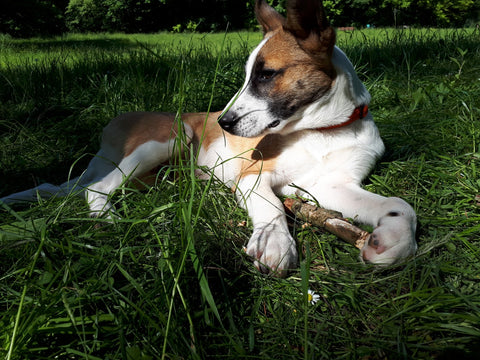Your Cart is Empty
Flat Shipping Fee of just $7.90 within USA

A strain in the dog is not uncommon - just like us humans, the four-legged friends can stretch their muscles and injure themselves. Here you can find out more about the symptoms and treatment options for a dog strain.
Your doggy friend was still romping around in the park as if he were in dog paradise. But now he looks a bit tired? Sure, he got a little out of breath from the action. However, if he limps or takes up a protective posture, these are symptoms that indicate a strain.
Tendons, muscles or ligaments are injured if they are pulled. There can be different reasons:
Strains usually appear in the hips or thighs. The overstretched and injured tendons cause severe pain for the dog and are accompanied by certain signs.

A strain in the dog can manifest itself in different ways. You can recognize the injury by the following typical symptoms:
Note: The symptoms mentioned can also indicate a sprain or a torn muscle. In order to clarify what is wrong with your dog, a visit to the veterinarian is advisable.
The veterinarian will examine your dog's muscles and bones. Additional examinations such as ultrasound or an X-ray examination may be necessary to make a diagnosis.
Support the doctor by informing him exactly about the circumstances under which the injury occurred. He will also want to know when you first noticed a change in your dog.
In addition, describe to the veterinarian how the behavior of your furry friend has changed: for example, is he sleeping more? Is he limping? Doesn't he want to go for a walk? Doesn't he have appetite?
The therapy depends on the type of injury. The vet may put bandages on the dog and administer pain medication. You can also support your dog friend in his recovery.
In any case, rest is important for him so that he can recover. Only go out with your dog as much as necessary. Foolhardy jumps and brawls with the playmates should be completely prevented for at least two weeks.
One wrong move can be enough to rekindle or worsen the symptoms. Only if your dog shows no behavioral problems for several days and runs normally, then you can literally let him off the leash again.

If your dog has no open sores, home remedies such as arnica ointment can help as drops. The homeopathic substances are suitable for washes or compresses and support a quick recovery in the event of a strain.
Apart from that, you should cool the affected area regularly. This will reduce any swelling. You can relax your dog's muscles with massages and underwater exercises.
You can prevent dog strains by keeping your four-legged friend at a healthy weight. A healthy and balanced diet is also important to protect your fur nose from many diseases. Even with regular exercises, you can make your dog's muscles fit and less prone to injury.
By BOLLI LLC I September 9, 2020 I www.bolli.dog I Follow @bolli.dog